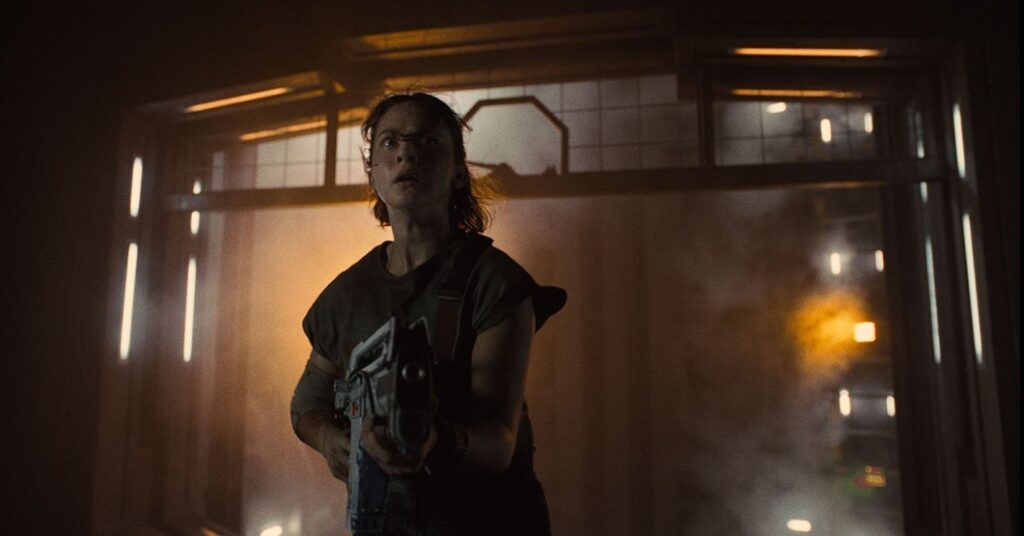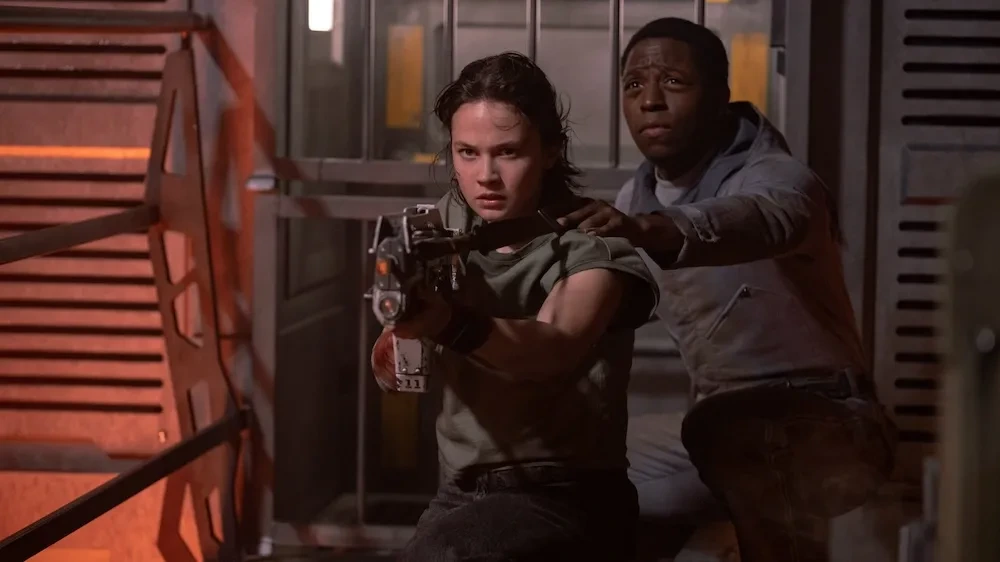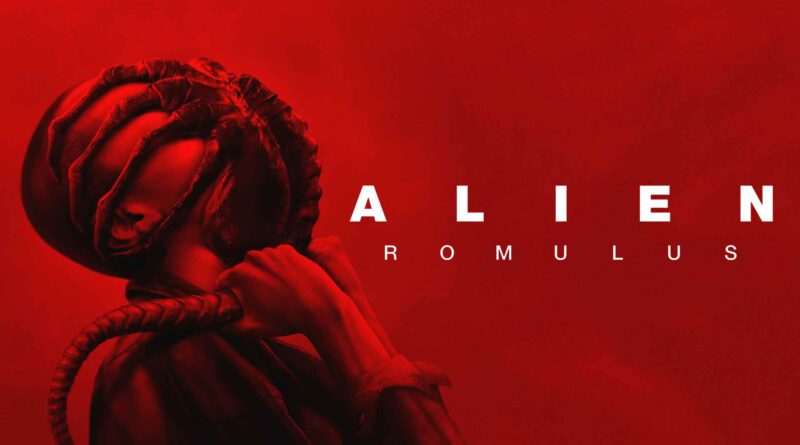“Alien: Romulus”: Alvarez Is Back To Basic, And It’s Basically Awesome | Review
In the world of horror, we’ve learned that it’s never too late for (another) sequel: yes, even 45 years, with quite a few other films in the franchise in between. “Alien: Romulus” is the seventh in the hugely successful “Alien” franchise, if you ignore the very unnecessary crossover films with “The Predator,” but chronologically, it takes place between that 1979 masterpiece and “Aliens,” considered by many to be one of the best sequels ever.
With a great director named Fede Álvarez, who is responsible for some of the finest horror thrillers of recent years, a promising young cast (led by the super talented Cailee Spaeny), some very effective action scenes, and a lot of love for the genre, we got one of the best horror films of 2024.
What Is Alien: Romulus About?
“Alien: Romulus” takes place in 2142 – that is, 20 years after the events of Alien (which takes place in 2122) and 37 before the events of “Aliens” (2179). The location, at least at the starting point, is a perpetually dark planet named “Planet LV-410”. A corporation controls the planet and manages, among other things, a human colony called “Jackson.”
Marie Raines “Rain” Carradine (Spaeny) is an orphaned miner who dreams of relocating, only to discover that the corporation has plans for her for years to come. She ultimately decides to leave the planet and embarks on a long journey – nine years, including a necessary freeze, of course – to a planet called “Yvaga III,” which is fortunately not controlled by the same evil corporation.
Rain embarks on a journey with her brother Andy (the little-known David Jonsson), an android that Rain’s father programmed to act as her brother and take care of all her needs, and another group of characters, most of whom will probably die: The Ex Tyler (Archie Renaux, “Gold Digger,” “Morbius,” “Upgraded”) and his pregnant sister Kay (Isabela Merced, “Transformers: The Last Knight,” “Instant Family,” and of course Dora in “Dora and the Lost City of Gold,” speaking of horror movies) and their cousins, Bjorn (Spike Fearn) and Navarro (Aileen Wu).
The main problem is that the abandoned research station, where the guys arrive to find those freezing chambers, is not exactly abandoned. They accidentally release the monstrous creatures known as “facehuggers” (the second stage in the metamorphosis of an Alien) because they tend to hug the face of the person they want to do terrible things to. Thanks to a technological reconstruction of one of the familiar characters from the original film, they discover that the corporation has been conducting experiments at the research station to reverse-engineer the DNA of those Xenomorphs, with a super desire to create perfect humans eventually. It is clear that things got out of control at some point during the first film’s events. The gang from the current movie finds themselves fighting for their lives against many monstrous dangers, or more precisely, those related to fictional alien parasites.
Here is the trailer for “Alien: Romulus”:
Introducing Rain Carradine: Not Ellen Ripley, But Hell Of A Fighter
To say that Cailee Spaeny stepped into big shoes is an understatement. Sigourney Weaver played the iconic character of Ellen Ripley at the age of 30, creating one of the most iconic and beloved horror heroines for several films. In the following “generations” of the franchise, the prequel “Prometheus” from 2012 and the sequel of the prequel “Alien: Covenant” (2017), we saw other tough girls – Noomi Rapace and Katherine Waterston, for example – perhaps as part of the new femininity, the blurring of the boundaries between genders (a theme that was already prominent in the first films), and so on.
Cailee Spaeny is different from them. Her appearance is more innocent, or if you like, less strict, but probably only for appearances. The young Spaeny was about the only good thing about the disappointing “The Craft: Legacy,” proving herself in dramatic roles in films like “On the Basis of Sex” (speaking of women fighters, this time in court) and especially “Priscilla,” in which she played Elvis Presley’s wife and a fascinating personality in her own right (a role for which Spaeny received a Golden Globe nomination), and also stood out as a militant photojournalist in “Civil War.”
With toughness, charisma, and emotion that develops as the film progresses, she could become one of the most prominent stars of the coming years. We have not yet heard whether she will be part of the cast of the following “Alien” film, directed by Alvarez, but we can assume that she will. We will also see her soon in “Wake Up Dead Man,” the third film in the “Knives Out” series, which is super enjoyable, alongside names like Daniel Craig, Glenn Close, Mila Kunis, Josh Brolin, and others.

The Cast Of Alien: Romulus Makes A Difference
The truth is that the choice of a young cast is interesting or even a little risky. If we are used to seeing in the “Alien” films mainly relatively older astronauts (except for female characters in a male environment, like Ellen Ripley), here we see a cast that seems to have come out of a typical slasher film, some would say also teen films in other genres (in one of the reviews, I saw a comparison to works like “The Breakfast Club”).
Alvarez said he got the idea from a scene not ultimately included in “Aliens,” except in the extended edition, where a group of children run around the space colony. “So when I saw those kids, I remember thinking, ‘If I ever tell a story in that world, I would definitely be interested in those kids when they reach their early twenties, and what they want to do and where they want to go,'” he said.
The heroes, in their early twenties, are simply trying to find a better future for themselves and don’t necessarily set out to save humanity, and this modesty does the film well. Of course, there is a theoretical engagement here with issues that were also present in other films in the franchise, with an emphasis on the representation of women in cinema and gender reversal (Ellen Ripley is a character who is perceived as “masculine” and also behaves in a way that is opposite to the standard portrait of women in cinema, according to some of the standard theories on the subject), and issues such as the female body, parenthood, and motherhood, with terms like “Avoidance,” “Castration Anxiety” and “the Queen Mother,” which will put you in the shoes of film students.

Back To The Origins, With A Modern Twist
“Alien: Romulus” takes place in 2142, but it was made in 2024, and you can see this at the production level or even the script. The android’s character raises, among other things, the ability of artificial intelligence, or its limitations, to perform a specific task or solve a particular problem. Relatively unknown British actor David Jonsson, who plays the robotic character, actually succeeds in expressing emotion and evoking sympathy.
In terms of filmmaking, we saw a reconstruction of one of the characters from the original film, who has since passed away (Ian Holm). He was reconstructed here in a rather impressive way in terms of appearance, voice, and facial expressions with the help of artificial intelligence. This representation is not perfect, probably intentionally, but we get another film that directly and indirectly addresses one of Hollywood’s most prominent and hottest issues today.
Surprisingly enough, the script that Alvarez wrote with his collaborator Rodo Sayagues (the two co-wrote “Evil Dead,” “Don’t Breathe,” and “Don’t Breathe 2,” which Sayagues also directed) is innovative and gives space to the characters. Most of the characters here are interesting, even developed, thanks to the film’s relatively slow pace.
So it’s true that most characters will die because we’re in an “Alien” movie after all, but the audience cares about a large portion of them for a change. The acting is usually very impressive, with Jonsson and Spaeny standing out. Jonsson also stepped into big shoes here because, in previous films in the franchise, actors like the late Ian Holm and Michael Fassbender played androids with great success. The other characters are sympathetic, even when they behave intolerably towards others or even when some of them are antipathetic.

Fede Álvarez Proves Again: He’s Here To Stay
Uruguayan director Fede Álvarez has proven he’s one of the most promising names in horror cinema in recent years. Despite having the name of a soccer player – or at least, a Uruguayan guy’s name because the other celebrities I know from Uruguay are football players – there’s no doubt that he’s a first-rate director among horror filmmakers today.
Alvarez started with a short YouTube film, later signed with Ghost House Pictures, and directed “Evil Dead” in 2013, a direct sequel to the first film in the franchise from 1981 and the fourth overall in the franchise. Alvarez received a budget of about $17 million, made a film that received much praise and brought in almost $100 million worldwide. In 2016, he produced, wrote, and directed the excellent “Don’t Breathe” (in fact, he is also responsible for part of the soundtrack) on a tiny budget of about $10 million and created a film that was loved by the audience (about $157 million in revenue worldwide) and critics alike. Then came a few more films, such as “The Girl in the Spider’s Web,” which Alvarez wrote and directed; the average sequel to “Don’t Breathe 2,” which he wrote and produced; and the sequel to “The Texas Chainsaw Massacre,” produced by him as well.
There is no doubt that his biggest project to date is “Alien: Romulus,” both in terms of budget (reportedly around $80 million) and expectations, and Alvarez proves once again that he simply knows his stuff.
“Alien: Romulus” is not a perfect film because some would say it’s a bit too long and has a few script flaws. The film allows even those who haven’t seen the previous films to understand what’s happening. Still, we recommend being familiar with the franchise, or at least the first few films, since this familiarity can make it easier for you to understand the plot and identify the references to the other films in the franchise or even to the video games of “Alien.” Alvarez said, for example, that he was also influenced by the computer game “Alien: Isolation,” which he played while working on “Don’t Breathe,” and that he wanted to take the film in that direction. The early introduction can also help you understand the plot better. Otherwise, you’re likely to be bombarded with all sorts of terms that seem like they came from an academic course on molecular biology and alien genetics in space, material theory, or whatever the hell it is.
Alvarez demonstrates excellent control of the genre. He builds the tension gradually, gets decent performances from the cast, and effectively directs the action sequences. Along with the film’s gradual build-up of stress, he creates several tense scenes that show – as in “Don’t Breathe” – that the guy knows how to keep viewers glued to their seats.
Not everything here is original or breathtaking, both in terms of the mythology of the “Alien” films and other horror conventions, and there are a few predictable scenes here. But sometimes the familiar is also good, especially when it’s well-made.

Is Alien: Romulus Scary?
Of course, there is more than a hint of horror in the film, especially in the second part, which includes confrontations with the Xenomorph and many other monstrous creatures. In this part, you will find more blood, organs, and grotesque creatures that come out of people’s bodies, including intimate places. Alvarez relies mainly on practical effects here and less on computer animation (although there are quite a few effects here, as befits a film with a budget of about $80 million). According to reports, he even hired the team responsible for the excellent effects in “Aliens” to work on the visual effects and the creatures. Most of the time, it works well.
Alvarez correctly positions the camera to create fear on the one hand and allow us to understand the complexity of the location – an abandoned spaceship. The spaceship is full of corridors that, on the one hand, make the escape from the creatures possible, but on the other hand, increase the threat because a creature could appear from anywhere. He builds games on light and darkness, but unlike other films that are too dark and gloomy so that it is difficult for the viewer to see anything without cutting our veins and destroying our eyes, here the darkness serves him to show things that the viewer can see, but the characters cannot. Yes, those monstrous creatures that sneak up from behind are on the wall or the ceiling, and so on.
Should You Watch Alien: Romulus?
They say that “Alien: Romulus” was initially intended to be aired on Hulu, but in the end, they decided to give it a chance in theaters, and that’s a good thing. Alvarez even wanted to hide from viewers that this was a film from the “Alien” cinematic universe until they saw the familiar creatures on the screen.
Ultimately, the creators realized it was impossible to promote the film without revealing what it was about, especially when we come to most films with too much prior knowledge. The film ultimately grossed over $350 million, and the big screen certainly did well to it (even when viewed at home, as you can now, it is worth almost two hours).
Even if it is still impossible to compare “Alien: Romulus” to the masterpieces that essentially established the space-action-science fiction horror genre – especially the perfect “Alien” and “Aliens” – we can argue with complete confidence that this is one of the more successful films in the franchise, an enjoyable film that manages to captivate us almost from beginning to end.
Just as importantly, it’s a further testament to Alvarez’s talent, that some of the cast is poised to make it big, and that the “Alien” franchise is still alive, breathing and killing it. At least until 2027, when the eighth film in the franchise should arrive.
Alien: Romulus – Frequently Asked Questions
When was Alien: Romulus released? The release date of “Alien: Romulus” to theaters in the United States is August 16, 2024.
Who Directed Alien: Romulus? Uruguayan filmmaker Fede Álvarez, the man behind the 2013 remake of “Evil Dead,” “Don’t Breathe,” and others.
Who wrote Alien: Romulus? Álvarez and Rodo Sayagues wrote the script.
Who Played in Alien: Romulus? The cast of “Alien: Romulus” includes Cailee Spaeny, David Jonsson, Archie Renaux, Isabela Merced, Spike Fearn, and Aileen Wu.
How long is Alien: Romulus? The duration of the film is about 119 minutes.
When was the movie produced? In the United States, United Kingdom, Hungary, Australia, New Zealand, and Canada.
What was the budget of the film? The budget of “Alien: Romulus” is about 80 million dollars.
How much did the movie gross? The numbers of the movie are pretty good, with a worldwide gross of approximately 350 million dollars, according to Box Office Mojo.
What is the MPAA rating (Parent guide) of Alien: Romulus? The film is rated Rated R for bloody, violent content and language.
What do The Reviews Say About Blink Twice? The film got mostly positive reviews. It has a 7.1 rating on IMDB and only 80% positive reviews on Rotten Tomatoes.




